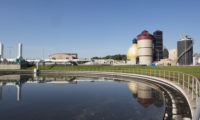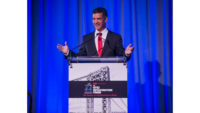When a retaining wall collapsed on CSX railroad tracks in Baltimore on April 30, 2014, city officials quickly called on engineering firm Whitman Requardt and Associates for help. About 45 minutes after the emergency phone call, Jim Guinther, a WRA vice president and the firm’s point man, arrived at the East 26th Street site. He was shocked to see that the 35-ft-high stone barrier had damaged not only the rail line but the sidewalk, roadway, street lights and cars, too. Emergency personnel were knocking on doors of row houses just 30 ft away, alerting residents, who fled carrying their possessions. “It was raining so hard we didn’t know if we would have additional collapses,” Guinther recalls. “We turned off all the utilities and stayed there through the night monitoring the area.”
Baltimore-based WRA, working under a long-term “open-ended contract” with the city, devised a plan to stabilize the crumbled cliff with a temporary 20-ft-high rock buttress using existing debris as well as a temporary soldier pile and lagging wall with tie-backs along the centerline of East 26th Street. Within two days, CSX’s trains were running again. By June 1, residents were able to return to their homes—nine days ahead of Mayor Stephanie Rawlings-Blake’s 40-day deadline to restore utilities. A permanent reinforced concrete wall was completed Jan. 7, 2015.
The quick and successful response is only one of many examples of WRA’s long commitment to and extensive work with local, state and federal government agencies in the Mid-Atlantic region and beyond.
Thanks to its internal growth and recent expansions into new markets, WRA saw its revenue rise 12% in 2015. That moved the firm—which has about 725 employees in 18 offices in seven states, including Delaware, Pennsylvania and Virginia—to No. 10 on ENR MidAtlantic’s regional list of Top Design Firms, up from No. 12 the previous year. WRA also advanced to 112th on ENR’s national Top 500 Design Firm list, from No. 114 the prior year.
The firm supports more than 75 different community programs and nonprofits in the cities where it has offices. And it works with at-risk youth from four Baltimore schools, including programs to introduce high schoolers to engineering disciplines. It also awards an annual scholarship to help one student offset the costs of books during the first year of college.
WRA is run by a 12-person executive committee, including four partners who have all been with the firm for more than 20 years, and who remain deeply involved at the project level. For all these reasons, Whitman Requardt & Associates has been selected as ENR MidAtlantic’s Design Firm of the Year.
“We are proud of being involved in projects that improve society,” says Joe Makar, managing partner. “People take infrastructure for granted, and I don’t think you can take infrastructure for granted. It’s a very important part of what we do.”
The 101-year-old firm was established in the wake of the 1904 fire that destroyed much of Baltimore, sparking efforts to fortify the city’s infrastructure. One of WRA’s founders, Ezra Whitman, rose to the challenge by designing the city’s water and wastewater facilities. One of Whitman’s projects, the Montebello Water Treatment Plant, opened in 1915 and was credited with stemming a typhoid epidemic that killed nearly 30,000 people. WRA recently updated the plant to comply with the Safe Drinking Water Act.
Since those early years, WRA has become a multidisciplinary firm. About half of its revenue comes from transportation. Water systems, including pipelines, pump stations and wastewater treatment plants, account for 25%. Another 20% is from buildings, including architecture, interior design and mechanical, electrical, structural and civil engineering.
Five years ago, WRA formalized its specialized protective design/security group, which focuses on hardening federal government facilities, campuses and critical infrastructure to withstand natural and man-made disasters. The work goes well beyond designing secure perimeter fencing and checkpoints. It requires in-depth knowledge of electronic security systems as well as chemical, biological and radiological filtration and detection systems.
WRA ensures that these buildings comply with complex Dept. of Defense security requirements for new and renovated buildings, including DOD’s Minimum Antiterrorism Force Protection Standards. Other agencies, such as the Dept. of Homeland Security, have their own requirements for design firms to follow. “It’s another kind of building code that is now on top of all the other criteria you have to meet,” says partner David McCormick, who leads the group.
The group designed the headquarters for the Army’s new 20th CBRNE Command in Aberdeen, Md. WRA renovated two abandoned facilities to form one complex for the Army’s specialized unit that deals with chemical, biological, radiological, nuclear and explosives threats.
WRA reevaluated the buildings to determine the necessary setbacks as well as the perimeter wall, window and door strengths. “When there are chemical or biological weapons used in a battlefield environment anywhere in the world, these are the guys that collect the samples and try to mitigate the damage,” McCormick says. “It’s scary stuff, and all we’re doing is providing their building. But when you understand what they do, you really start to feel proud of what we bring to their readiness.”
WRA’s port and marine group also adheres to ever-changing DOD standards on facilities that house U.S. Navy submarines and aircraft carriers. WRA is one of a select group of firms across the country qualified to perform specialized inspections and certifications on the Navy’s marine facilities. “It’s the Navy’s insurance policy to make sure that a ship at that dry dock is safe,” says Jeff Giza, senior vice president of port and marine work. “We are one of the only firms that does that for the Navy.”
Besides its projects for major federal agencies, WRA also has a heavy workload of projects for small municipalities that lack an in-house engineering staff. In fact, the full breadth of WRA’s services can be seen in the work it performs for Ocean City, Md.
Since 1974, WRA has provided Ocean City with civil, sanitary, structural, environmental and transit engineering services, aiming to ensure that the beach resort’s 7,200 year-round residents and approximately 300,000 daily summer vacationers aren’t affected by infrastructure failures.
Hal Adkins, Ocean City’s public works director, likens WRA to a family physician. “We rely on Whitman,” he says. “Whitman is an extension of my staff. They are part of my family. We have worked extremely well together over the years.”
In Ocean City, the firm is currently constructing a 100-ft-tall, 1-million-gallon water storage tank designed to look like a gigantic beach ball in addition to a $4.5-million secondary wastewater treatment tank. WRA also is in early design stages for a $25-million transportation depot for the city.
Such government contracts allowed the firm to grow during the recession and also put it in a position to move into new markets, such as Texas, where WRA acquired Maintenance Facility Consultants in 2010 and has since continued its internal growth.
WRA is looking at expanding into North Carolina and is focused on increasing wastewater-management work in Pennsylvania.
The firm is also growing its higher-education portfolio in Maryland, Virginia, Pennsylvania and Washington, D.C. In addition to continuing to develop its relationship with the University of Maryland, WRA is working on the Towson University Union expansion and renovation. It also has on-call contracts with American University and the University of Virginia that cover full design services on various campus upgrades.
Makar says the firm doesn’t see forging into new markets as risky. “We think it’s exciting, to be honest,” he says. “We like that … any firm that wants to stay dynamic and be a really first-class firm has to grow.”
For WRA, growth also means recruiting, training and nurturing young talent for a long and fruitful career. WRA has approximately 12 interns each summer and usually hires 12 new graduates each year. Many of those entry-level engineers end up spending their entire career at WRA.
“This firm is like a train,” says Makar, who joined in 1993 as an associate. “You get on and you have some fun. You might blow the whistle, but you make the train bigger and stronger, and then you hop off and the train keeps going.” He adds, “That’s the goal: When you walk away, you are proud of what you are leaving for everybody.”









Post a comment to this article
Report Abusive Comment